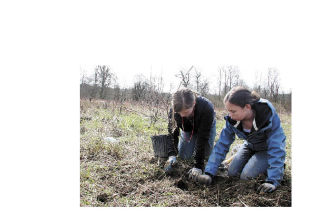Ell Wilson’s blond hair glowed in the sun as she kicked her muddied boot down onto the shovel blade, driving it through the layer of matted reed grass and into the heavy soil below.
After digging a small hole, her father, Tom Wilson, placed a dogwood sapling, and the two began filling in the gaps around the tree’s root ball.
The tree was one of dozens being planted in a broad field beside the Snoqualmie River by Ell and her sixth grade classmates from Snoqualmie Middle School. The project is part of their science class, which partnered with the Stilly-Snohomish Fisheries Enhancement Task Force.
The task force is organizing the restoration of 25 acres of floodwater forest in the Stillwater Wildlife Area with the help of community volunteers, including students. The site is owned by the Department of Fish and Wildlife, which is helping to pay for the project.
Cara Ianni oversees the task force’s education program.
“I want students to understand how trees save fish,” she said, walking through the muddy, flat plain.
Ianni stopped, lifted an orange whistle to her lips and blew a piercing shrill.
“Everybody! Look, bald eagles!” she yelled to the 30 sixth graders planting saplings. She pointed to the far side of the field, where four bald eagles were circling.
“They’re going to be eating the salmon you’re saving,” Ianni told the students, half-joking.
The students have learned about life and death in a freshwater river from Ianni and their science teacher, Gary Moen.
The program has three goals, said Ianni. First, to teach the students how Puget Sound watersheds work. Second, to teach how human behavior can affect a watershed. And third, to help teachers meet curriculum requirements.
The students’ project- and inquiry-based curriculum had them design and implement a salmon habitat restoration project. The students had to apply classroom lessons to real-world mud and grass. In the fall, the students waded into the Snoqualmie River to measure its characteristics, such as temperature, turbidity and oxygen-levels.
They assessed the area’s soil, light and existing vegetation, such as the invasive reed canary grass that has overrun open areas. The students also conducted experiments to determine which tree species would grow best through the thick layer of grass, and chose which species to plant based on the results.
The trees “give the water shade so it keeps it cooler, so there’s more oxygen in it. And it keeps the dirt from eroding and going into the river,” Ell said.
Getting their hands dirty helps students retain the lessons better than just reading from a textbook, said Moen, the science teacher.
Several students said one of their favorite lessons was when Ianni brought in five dissected salmon which had died after spawning.
“We all put on our plastic gloves, and got to handle the fish,” Moen said. “It smelled pretty fishy in here, but it was great science.”
For more information, go to www.stillysnofish.org.


